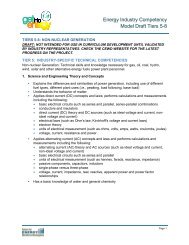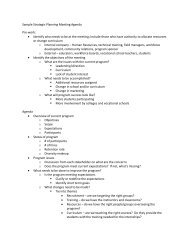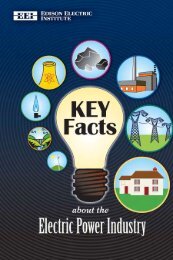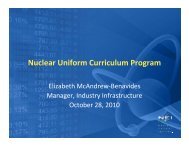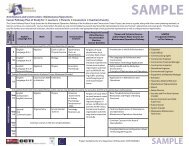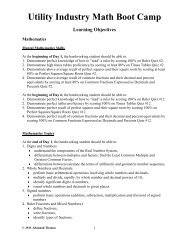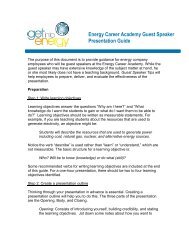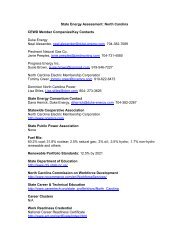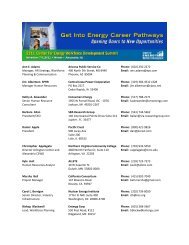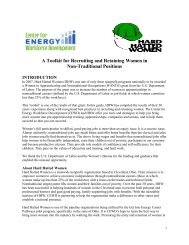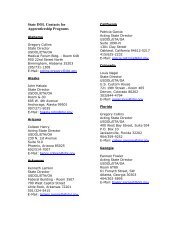Curriculum Framework for Energy Industry Fundamentals Certificate ...
Curriculum Framework for Energy Industry Fundamentals Certificate ...
Curriculum Framework for Energy Industry Fundamentals Certificate ...
Create successful ePaper yourself
Turn your PDF publications into a flip-book with our unique Google optimized e-Paper software.
<strong>Curriculum</strong> <strong>Framework</strong> <strong>for</strong> <strong>Energy</strong> <strong>Industry</strong> <strong>Fundamentals</strong> <strong>Certificate</strong> ProgramThe <strong>Energy</strong> <strong>Industry</strong> <strong>Fundamentals</strong> course content focuses on understanding varioustypes of energy and their conversion to useable energy such as electrical power. Howgenerated electrical power is transmitted and distributed to the point of use.01.0 Demonstrate knowledge of the basic and emerging principles and concepts thatimpact the energy industry the student will be able to:.01.01 Explain the flow of energy from generation through distribution to thecustomer.01.02 Discuss the history of the United States energy industry/infrastructure(refer to <strong>Energy</strong> In<strong>for</strong>mation Administration www.eia.doe.gov ).01.03 Identify the role and function of generation, transmission and distributionorganizations.01.04 Explains the role of regulatory bodies in the energy industry (Federal<strong>Energy</strong> Regulatory Commission www.ferc.gov ; Public ServiceCommission of the State of Florida www.psc.state.fl.us ) (highlight“obligation to serve”).01.05 Discuss environmental laws and regulations that impact the energyindustry (local, state, and federal) and explain importance of properdocumentation to ensure compliance.01.06 Explain the different structures of energy companies, including investorownedutilities, municipalities (and associated utility practices such aswater/wastewater), electric cooperatives, independent power producersand can explain the different lines of energy business, including electricand gas.01.07 Describe the process of electric metering and billing <strong>for</strong> energyconsumption.02.0 Apply compliance with procedures necessary to ensure a safe and healthy workenvironment the student will be able to:02.01 Review the role of the U.S. Department of Labor/ Occupational Safetyand Health Administration in work place safety.(http://www.complianceregs.com/29cfr/1910/subR/1910269.html)02.02 Identify both potential hazards and accident scenarios in the workenvironment.02.03 Follow established safety procedures (OSHA regulations and utilitycompany procedures).02.04 Evaluate changes in the environment with respect to their impact onsafety of self and others.02.05 Promote effective local, state, and national security operations <strong>for</strong> theprotection of people, data, property and institutions.02.06 Comply with energy industry safety procedures and proper ways toper<strong>for</strong>m work.02.07 Name potential threats created by deviation from safety procedures andimproper use of tools and equipment.02.08 Use safety equipment as specified by user manuals and safety training.
02.09 Use Personal Protective Equipment (PPE) including safety glasses,hearing protection, gloves, work boots, and hard hats.02.10 Keep personal safety equipment in good working order.02.11 Use tools and equipment in compliance with user manuals and training.02.12 Call attention to potential and actual hazardous conditions as they arise.02.13 Alert coworkers and supervisory personnel to hazardous conditions anddeviations from safety procedures in a timely manner.02.14 Maintain appropriate certification and is knowledgeable in first aid or firstresponse procedures.02.15 Demonstrate understanding and knowledge of lock/tag out practices inthe work place.02.16 Notify person in charge and/or coworkers of unsafe work conditions.02.17 Stop the job if there are unsafe working conditions.03.0 Understand electric power generation the student will be able to:03.01 Explain the conventional electric power generation systems and process(coal, gas, hydroelectric, and nuclear).03.02 Identify electric power generation equipment and systems.03.03 Identify various conventional electric power generation fuel sources andthe cost/ efficiency/environmental issues associated with each:a. Explain how oil was created and list its advantages anddisadvantages.b. Explain how coal was created and what are its advantages anddisadvantages.c. Explain how natural gas was created and what are its advantages anddisadvantages.d. Explain how water is used in hydroelectric power generation and whatare its advantages and disadvantages.e. Explain how uranium is created and what are its advantages anddisadvantages.03.04 Discuss emerging and alternative electric power generation technologiesand fuel sources.03.05 Explain how solar energy is used to produce electricity in photovoltaicsystems and what are its advantages and disadvantages.03.06 Explain how solar energy is used to produce electric energy using steamand what are its advantages and disadvantages.03.07 Explain how wind energy is used to produce electric energy and what areits advantages and disadvantages.03.08 Explain how geothermal energy is used to produce electric energy andwhat are its advantages and disadvantages.03.09 Explain how biomass energy is used to produce electric energy and whatare its advantages and disadvantages.03.10 Explain how ocean wave energy is used to produce electric energy andwhat are its advantages and disadvantages.03.11 Discuss pros and cons of various energy producing technologies andfuels in the electrical infrastructure (including fossil, nuclear and emergingalternative energy systems).04.0 Understand electric power transmission the student will be able to:
04.01 Explain the electric power transmission process.04.02 Discuss the application of different electric power transmission principles(including AC vs. DC).04.03 Name electric power transmission equipment and systems.04.04 Discuss the emerging technologies in electric power transmission(including Smart Grid).04.05 Explain ownership/governance of the electric transmission system.05.0 Understand electric power distribution the student will be able to:05.01 Explain the electric power distribution process.05.02 Discuss the need <strong>for</strong> electric distribution systems and how they aredesigned to operate.05.03 Name electric power distribution system equipment and what the variouscomponents do.05.04 Discuss the emerging technologies in electric power distribution, includingdistribution automation and SmartGrid systems.06.0 Identify and describe careers and entry requirements the student will be ableto:.06.01 Describe entrylevel careers available in energy generation, transmission,distribution and the education/experience requirements <strong>for</strong> entry intothose positions, along with career development and advancementopportunities from those positions.06.02 Identify entrylevel careers available in business and corporate supportfunctions of the energy industry; describes the education/experiencerequirements <strong>for</strong> entry into those positions, and career advancementopportunities from those positions.06.03 Describe general wage/salary, benefits, and other advantages of careersin the energy industry.06.04 Explain the educational pathways available to gain training necessary <strong>for</strong>entry into energy careers at secondary and postsecondary levels(Partner to create <strong>Energy</strong> Education Portal).07.0 Evaluate and analyze energy ‘hot topics’ the student will be able to:07.01 Discuss the major sources of biomass.07.02 Define biofuels (e. g. ethanol, biodiesel, and methanol).07.03 Outline the pyramid energy flow including the different trophic levels.07.04 Describe the major sources, scale, and impacts of biomass energy.07.05 Draw and label a diagram of biomass plantations.07.06 List the advantages and disadvantages of using biomass <strong>for</strong> energy (e.g.CO 2 emissions, photosynthetic efficiency, cost, etc.).NOTE: HOT TOPICS WILL VARY BY STATE. THE ABOVE HOT TOPICS ARE FORTHE STATE OF FLORIDA.



